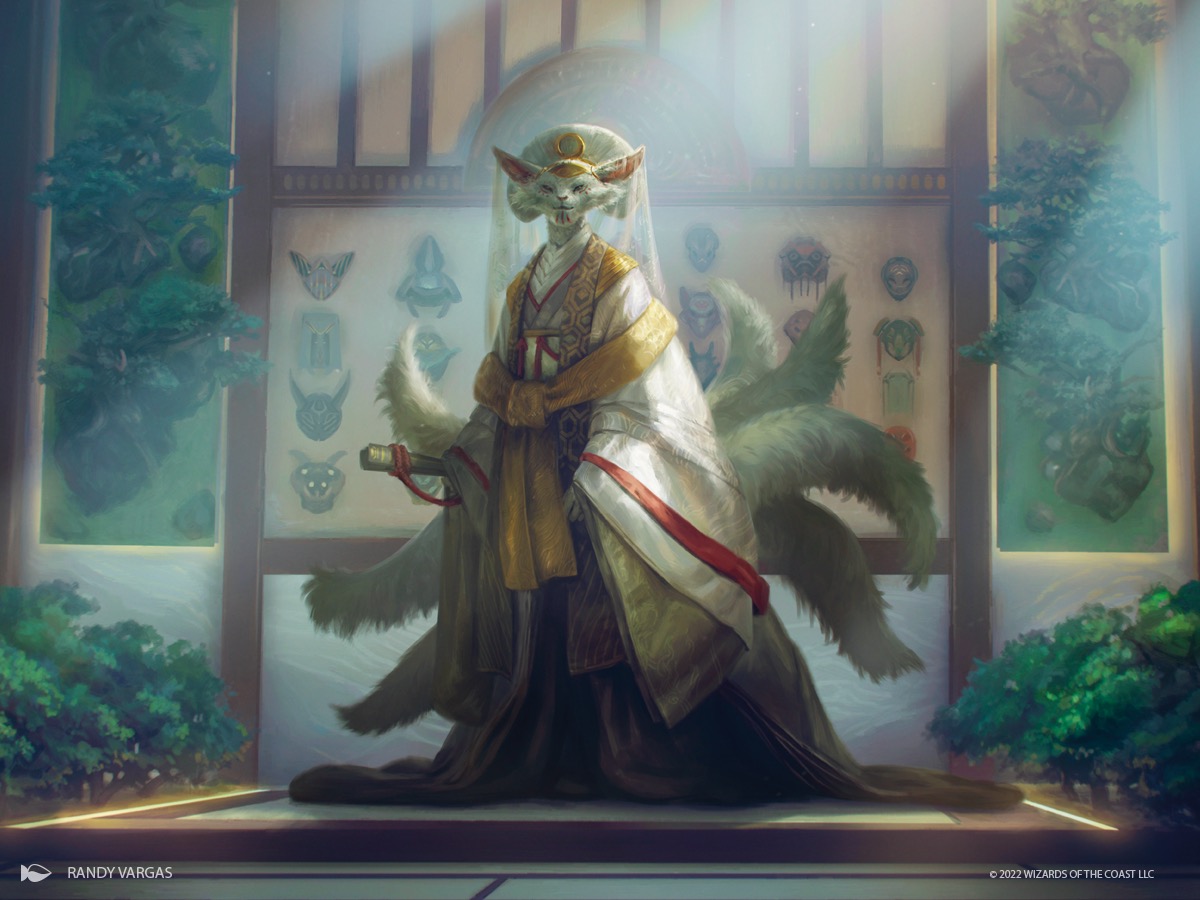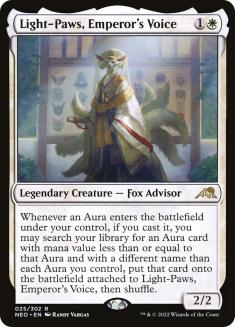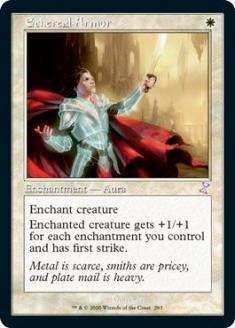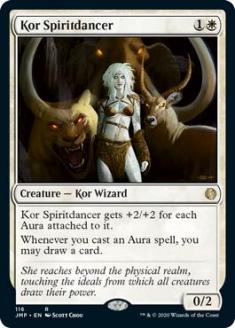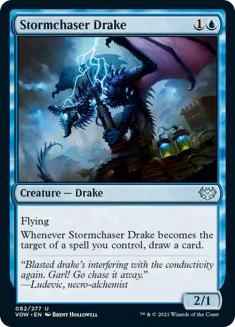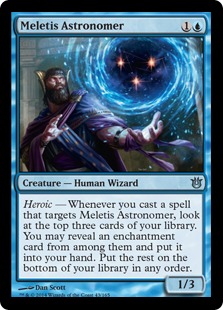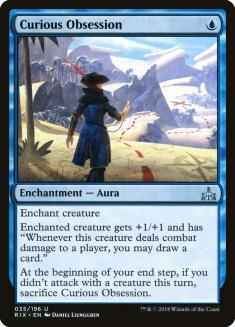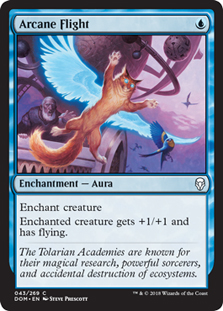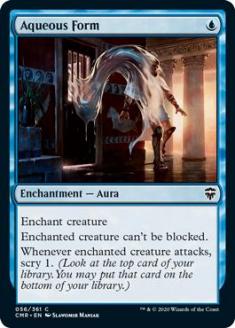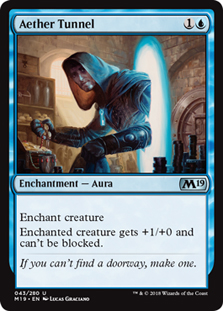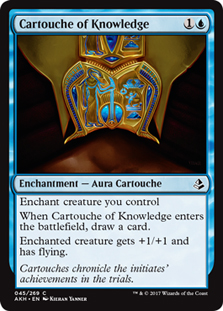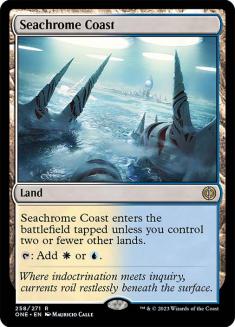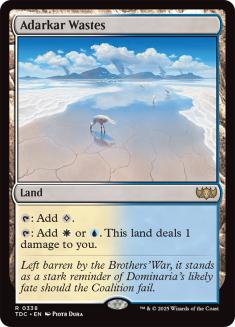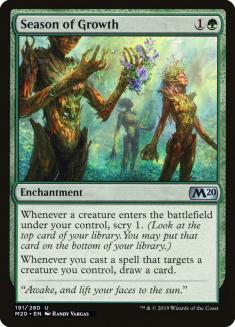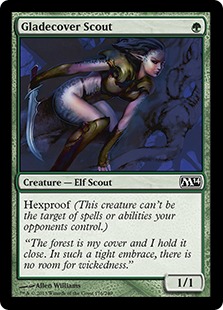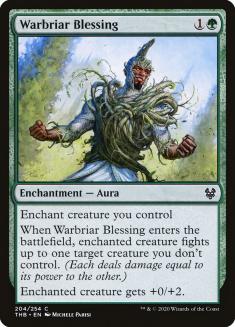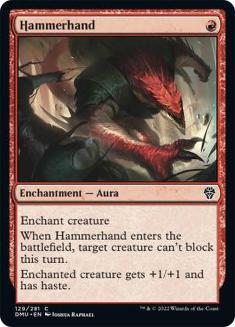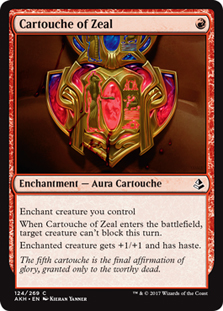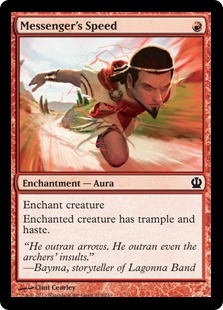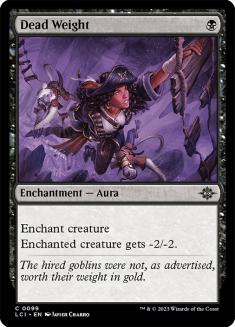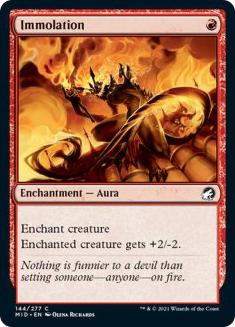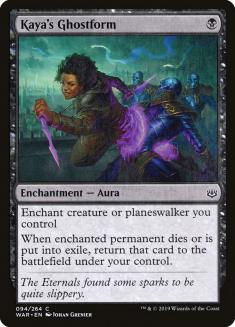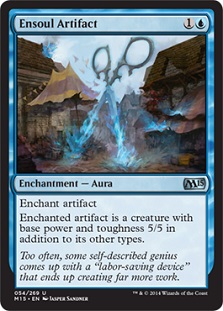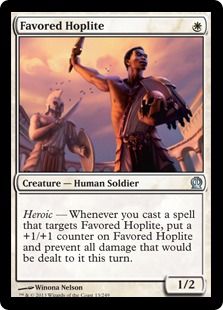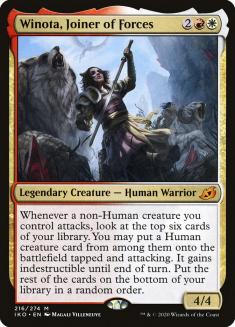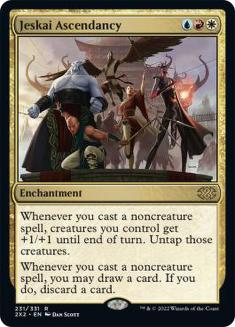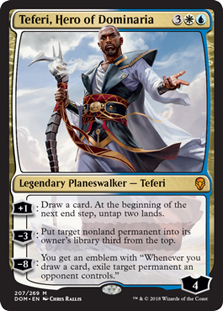Orzhov Auras was an early success story in Pioneer. Every established deck started life as a crazy idea in someone’s brain, and there’s no better brain for those ideas than Ken Yukuhiro:
Creatures (17)
- 2 Favored Hoplite
- 4 Sram, Senior Edificer
- 3 Aphemia, the Cacophony
- 4 Alseid of Life's Bounty
- 4 Hateful Eidolon
Lands (20)
Spells (23)

Just a few weeks later, Ikoria unleashed the scourge of companions on every format. Orzhov Auras inevitably became Orzhov Auras (Lurrus) — a free upgrade for a deck whose mana curve stopped at two anyway — and Auras vaulted into the top tier of Pioneer as the best Lurrus deck. Your opponent needed at least one removal spell early for your first threat, making it harder to answer the Lurrus that would let you rebuild immediately (as well as being a strong target for Auras itself). The deck already leaned heavily on Alseid of Life’s Bounty, a good candidate for that first threat as a cheap lifelinker or a shield for your actual threat, which now set up a protective loop with Lurrus that required even more effort to break through.
After the change to companions, an overdue and overreaching round of bans, and further developments in the format, Orzhov Auras (Lurrus) was largely forgotten. That won’t be true for much longer.
In his Auras guide from a year ago, Ari Lax identified the crucial differences between the version of Orzhov Auras that was all over Historic at the time and the lists you’ll see in Pioneer. Put simply: Historic has better creatures, while Pioneer has better Auras. The existence of Ethereal Armor allows you to apply pressure much more quickly in Pioneer, frequently amassing lethal damage by Turn 4, and this big boost in power is necessary because your creatures don’t have impressive stats as a baseline. In Historic, Kor Spiritdancer lets you build an impressive battlefield while drawing cards regardless of which Auras you play, pushing you towards Auras that do other things at the same time.
We may wake up one day to find Ethereal Armor has parachuted into Historic. For now, a potential replacement for Kor Spiritdancer in Pioneer warrants serious attention, but Light-Paws is a very different card in some important ways.
- Light-Paws can only attach Auras to itself. If you have another creature that’s already large but wants a form of evasion (or vice versa), Light-Paws can’t offer it that missing piece; its focus is entirely selfish.
This suggests a few different play patterns. You can use your first creature as bait to clear the way for Light-Paws, which can make itself a game-winning threat incredibly quickly. You can have Light-Paws bulk up for ‘free’ while developing your main threat so that, when that threat is removed, Light-Paws can pick up that torch immediately. Sometimes you don’t have to choose; you make two large threats at the same time and bulldoze through any resistance.
- The requirement for unique Auras presents you with a familiar temptation of filling your deck with situational Auras for Light-Paws to find. Be honest with yourself about if these cards will come up enough to be worth the slot, and if they are worth it compared to more copies of the good Auras you could be playing instead. The better way to skirt this requirement is to find other versions for effects that you know you want in some number — Gryff’s Boon is the best in its class, but perhaps Angelic Gift replaces the fourth copy for Light-Paws.
The mana value restriction comes in here too. Light-Paws will almost always pair a one-mana Aura with Ethereal Armor if you don’t have one, but additional two-mana Auras unlock All That Glitters as an Ethereal Armor by any other name.
Light-Paws and all the core cards mentioned here are mono-white, leaving all the white colour pairs on the table. Each of them has something to offer, so it’s worth asking why Orzhov is still the default.
Blue was the only colour that offered more two-drop engine cards before the arrival of Light-Paws. If you want more than eight total, you still have to turn to blue (and can support them with Selfless Savior as a one-drop), but this isn’t the unique selling point it was a few weeks ago.
The Curiosity variants let you build a must-answer threat in slower matchups without committing many Auras. Staggering Insight is the real appeal of blue and gets even better with Light-Paws, which bundles Insight and All That Glitters together to produce a gigantic lifelink creature.
If you want more Gryff’s Boons for the sake of Light-Paws, blue offers you a lot of Gryff’s Boons. Flying is effectively unblockable a lot of the time, but an effect like Aqueous Form or Aether Tunnel will win games no other card can when that difference matters.
Ultimately, the biggest drawback to blue remains the mana. The complete fixing cycles in Pioneer (other than shocklands) are terrible for a deck like this. Glacial Fortress can’t cast your one-drops on time, Deserted Beach doesn’t cast your two-drops either, and Hengegate Pathway only making one colour can trip you up (for example, putting Pathway on blue to cast Stormchaser Drake means you can’t cast three W one-drop Auras on Turn 3). Don’t get me started on Port Town…
Mana Confluence is an option, but a risky one in an increasingly fast and aggressive format defined by decks like Auras. The red aggro decks, in particular, will always be a popular choice, and that easy matchup becomes a lot harder when your draw relies on Mana Confluence.
If the allied colour pairs enjoyed access to their fastlands or painlands as the enemy colour pairs do, there would be a strong argument for blue. Until then, Azorius Auras is held back by its mana.
Green suffers from the same problem, yet has its own merits:
Season of Growth stands out as a reward for both your creatures and your spells that’s more durable than payoffs that are creatures themselves. Gladecover Scout is the most resilient threat among any build of Auras and the main draw to green. Warbriar Blessing is another perfect partner for Light-Paws. Any two-drop Aura can now double as a removal spell, a game-changer against the mirror or similar matchups and an important answer to cards like Thing in the Ice.
Red shares black’s smooth fixing but is locked into a more aggressive stance. The haste Auras are appealing in some number and let a mid-game Light-Paws immediately make a big attack (especially if it can find Ethereal Armor).
Black enjoys Dead Weight as a removal spell that triggers Sram, Senior Edificer (or Hateful Eidolon) and can be looped with Lurrus, but innocuous reprint Immolation does the same thing in red while also pumping your own creature in a pinch if something else is boosting its toughness.
Orzhov Auras has remained the default colour combination because of one card and despite another.
More so than any creature or Aura that fits your plan, the best argument for black is just the best black card in Pioneer. Thoughtseize is unrivaled as a form of disruption against other linear decks and poaches a crucial sweeper or removal spell against fair decks while giving you information to help you navigate around the rest of their hand. It’s your best tool against cards like Thing in the Ice that you can’t afford to maindeck specific answers for, yet also can’t let wreak havoc.
The play patterns of Thoughtseize line up nicely here too. Compared to reactive answers like Spell Pierce in blue or Karametra’s Blessing in any list, a Turn 1 Thoughtseize lets you curve out while still protecting your two-drop in exchange for not forcing the opponent to waste mana on their interaction. That trade-off tends to favour Auras, which is much more keen to end the game quickly than its Historic counterpart (though Karametra’s Blessing, in particular, is so back-breaking against most interaction that I like it somewhere in the 75 regardless).
The other big draw to black is obvious to anyone who has seen that Historic list in action:
Kaya’s Ghostform is infuriating for opponents hoping to contain Auras with sweepers or sorcery-speed removal in general, and is the perfect response to cards that dodge Selfless Savior like Portable Hole or Chained to the Rocks. While you lose the other Auras attached to the creature, you have enough cheap and impactful Auras that you can rebuild quickly (especially if that creature is Sram or Light-Paws, or its death gave you a new grip of cards via Hateful Eidolon).
Ghostform is a powerful weapon for Light-Paws. Any Aura can find Ghostform to protect Light-Paws the first time, and if it comes back via Ghostform, your first Aura on the rebound can just find Ghostform again. This in turn makes recastable Auras like Gryff’s Boon and Sentinel’s Eyes more important, as they can start this chain again immediately. This quickly exhausts your opponent’s removal, clearing the way for Lurrus to rebuild in its own way or for some other threat to finish the job. Ghostform allows Lurrus to make itself virtually invincible, in the mode of Alseid of Life’s Bounty. Casting Lurrus and recasting Ghostform on it is a common line in the mid-game.
These sequences are part of what allows the Historic list to take its time tightening the grip on the opponent, acting more like a prison deck than an aggro deck. In Pioneer, Kaya’s Ghostform is what lets this much more aggressive take charge forward with minimal risk.
Or at least, it should be…
Kaya’s Ghostform was unplayable on Magic Online for at least a year. With the pandemic stopping paper Pioneer play, Orzhov Auras had no opportunity to bring its best game. This didn’t stop it from sending some savvy players to the Set Championship or Magic Online Championship Series, but it wasn’t a fixture of the format as you might expect.
With this in mind, I thought Orzhov Auras might be an excellent choice for the Pioneer seat at SCG CON Indianapolis. Nobody has much recent Pioneer experience in paper, and people playing online won’t have encountered Auras (at least in its true form). The deck received a massive upgrade in Light-Paws. Finally, it seemed well-placed to exploit the format’s aggressive turn.
I think that cat is out of the bag:
Light-Paws wasted no time propelling Orzhov Auras to Top 8s even without Kaya’s Ghostform. Now that Ghostform is officially fixed, I expect the deck to be everywhere online and in paper in the weeks to come.
Part of the deck’s appeal is that other decks are trying to do a similar thing. Azorius Ensoul (Lurrus) was a big winner from Kamigawa: Neon Dynasty, thanks to Michiko’s Reign of Truth, but was overshadowed on its own breakout weekend by Boros Heroic (Lurrus) taking the top three slots in the Set Championship Qualifier. Orzhov Auras makes bigger creatures faster, often with lifelink; you can’t ask for much more in a race. These three decks apply roughly the same pressure on the format — have removal early and often, or go even faster.
The next step is harder to tease out. Naya Winota can go over the top of these removal-light linear decks, but runs into the wall of removal that everyone else has to bring in order to survive. Fast decks that ignore removal, like Four-Color Jeskai Ascendancy or control decks built to beat aggro, may be the move instead.
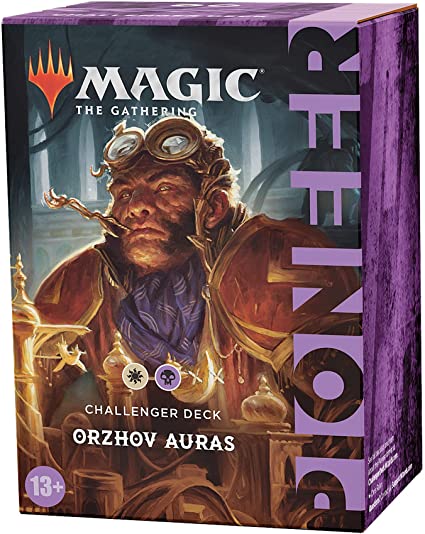
The Orzhov Auras Challenger deck is a cheap and easy introduction to Pioneer and gets you most of the way to what might be the best deck in the format. You will play against it a lot. Show it the respect it deserves, even if that means playing it yourself.
If Reid Duke wasn’t above playing Ethereal Armor, neither are you!

